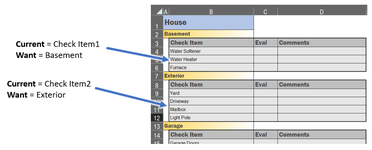I have a tricky one. I have code that creates tables automatically by looking for the words "Check Item" in column B and creating a table from 'Check Item' until the row before it hits a blank. (In the image attached, it created a table for (B3:D6) and (B8:D12). There could be A LOT of tables created. Currently, the tables are named "Check1, Check2, Check3, ..." as you can see in my code.
What I'm wanting to do is automatically (using VBA code) name each of the tables with the cell value above 'Check Item' (e.g. Basement, Exterior). I guess these values would be 1 above and 1 to the left (in column A).
Not sure if it can be done or not. Would greatly appreciate any help you can give me!
Sub CreateTable()
Dim lr As Long, i As Integer
Dim cll As Range, rng As Range
With ActiveSheet
lr = .Cells(Rows.Count, 1).End(xlUp).Row
Set rng = .Range("B1:B" & lr)
i = 0
For Each cll In rng
If cll.Value = "Check Item" Then 'find header row
i = i + 1 'count table
.ListObjects.Add(xlSrcRange, .Range(cll, cll.End(xlDown).Offset(, 2)), , xlYes).Name = "Check" & i 'create table
.ListObjects("Check" & i).TableStyle = "" 'Use blank format for table
.ListObjects("Check" & i).ShowAutoFilterDropDown = False 'Remove dropdown arrows for each column in table
End If
Next cll
End With
End Sub
What I'm wanting to do is automatically (using VBA code) name each of the tables with the cell value above 'Check Item' (e.g. Basement, Exterior). I guess these values would be 1 above and 1 to the left (in column A).
Not sure if it can be done or not. Would greatly appreciate any help you can give me!
Sub CreateTable()
Dim lr As Long, i As Integer
Dim cll As Range, rng As Range
With ActiveSheet
lr = .Cells(Rows.Count, 1).End(xlUp).Row
Set rng = .Range("B1:B" & lr)
i = 0
For Each cll In rng
If cll.Value = "Check Item" Then 'find header row
i = i + 1 'count table
.ListObjects.Add(xlSrcRange, .Range(cll, cll.End(xlDown).Offset(, 2)), , xlYes).Name = "Check" & i 'create table
.ListObjects("Check" & i).TableStyle = "" 'Use blank format for table
.ListObjects("Check" & i).ShowAutoFilterDropDown = False 'Remove dropdown arrows for each column in table
End If
Next cll
End With
End Sub






